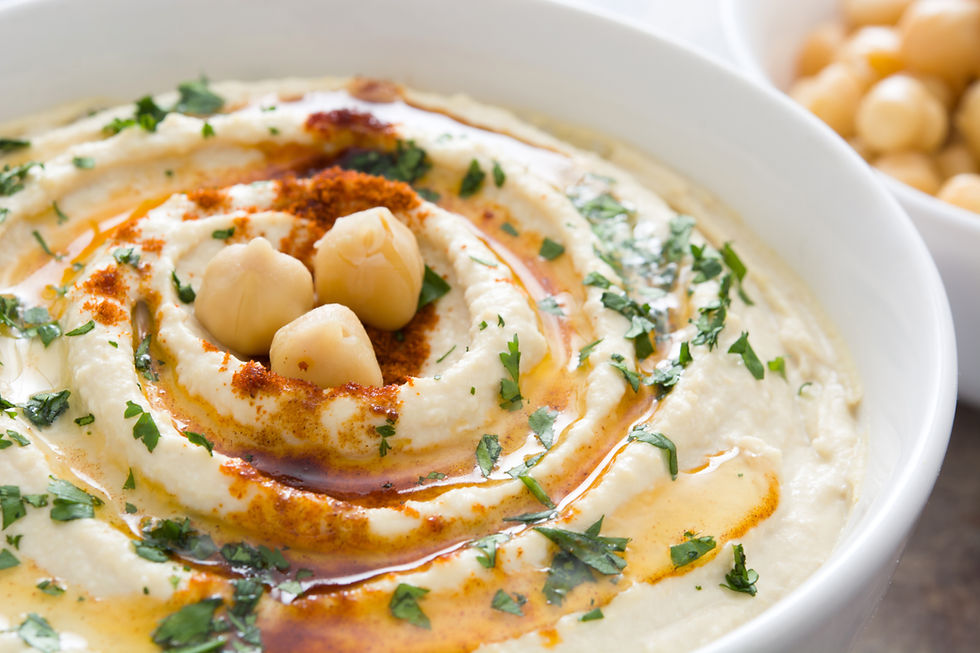Mashed.com recently reached out with some really great questions on making Hummus. Obviously, I have a lot to say on the subject!
Questions and answers below.

Should you cook chickpeas from scratch for the perfect hummus? If so, do you have any cooking tips?
Realistically, not everyone will cook chickpeas from scratch, even if it's the best option -
Do you have tips for picking the best-quality cooked canned/jarred chickpeas?
What are your opinions on chickpea-to-tahini ratio in hummus?
What ingredients do/don't belong in hummus?
What type of oil should you use in hummus?
Does ingredient quality matter?
Does it matter what order you blend the ingredients together?
Sometimes raw garlic can be a little sharp in hummus -
Do you have any tips to remedy this?
Do you have any other hummus-making tips to share?
1. Should you cook chick peas…? Purists will say that, yes, you must soak your dry chickpeas overnight - or 18 hours - with a teaspoon of baking soda to get the proper texture for the best hummus. But, please, who has time, or the patience for that! Using good quality canned garbanzo beans - chickpeas- is a perfectly fine alternative. Pro-tip: If you’re really fussy, rinse the chickpeas (but save their liquid) and with a tea-towel or kitchen towel gently rub the lot to remove their skins. Discard.
Pro-tip 2: It’s not necessary to cook them. Soaking them in water with a teaspoon of baking soda (per 15 oz can, or so) for 18 hours in the fridge will create the desired effect. The peas need to be just covered with water.
2. When buying canned chickpeas. Firstly, garbanzo beans and chickpeas are synonymous. Look for a quality brand. An international company like Sadaf or Golchin are always trustworthy. Stay away from generic grocery store labels - they tend to be smaller in size and not good quality. When draining chickpeas always save the liquid to use when making the hummus. You won’t use all of it, but it adds flavor to the emulsification and texture.
When buying dry chickpeas ( any type of dry bean for that matter), always pick through them to find any stones, or irregular peas. Rinse them thoroughly as well.
3. Here’s my fool proof beans to tahini ratio: 1 can (15 oz) beans, 1/4-1/3 cup tahini. Pro-tip: add 1/4 cup ice water (the ice is really important to add a frothy whipped consistency), and about 1/2 cup of the canned liquid. Juice of half a lemon ( or to taste, I tend to like a little more), 1 - 2 cloves garlic. Salt and pepper to taste.
4. & 5. Olive oil? To use or not to use, that is the question. I’m on the fence about using Olive Oil. I understand in some countries of the Middle East it is common to add a good drizzle of the liquid gold. In my opinion the tahini should provide that silken texture that the olive oil provides. Does it hurt? Absolutely not. So, have at it, if you like the flavor. Remember to use really good quality EVOO, though. Something fruity and light. Otherwise, you run the risk of it tasting bitter. That’s a no-go. Other than that, hummus is one of those dips that TikTok chefs are having a field day at reinventing. Beets? Why not! Feta, sure thing! Herbs, peppers, sundried tomatoes, even yogurt have found their way into some delicious looking (and tasting) hummus inventions.
6. Ingredient quality absolutely matters. As in all food prep and presentation. The better the quality the better the taste and the longer the shelf life. Though, hummus doesn’t tend to hang around for long.
7. When making hummus, typically you want to get the chickpeas, garlic and liquid going first to start the emulsification process. Then slowing adding, the ice water, lemon juice, salt and pepper. If you’re using other herb, feta, vegetables that should go in the food processor alternating with the liquid to get the cleanest purée. Finishing the processing with olive oil, if using.
8. Not a fan of raw garlic? Use Roasted Garlic instead! Roast a head of garlic in the oven (top cut off, drizzle with olive oil and salt and pepper) wrapped in foil at 425 degrees for about 25-40 minutes. Squeeze desired amount into processed with chickpeas and whirl away. Still not sold? Use a teaspoon ( or to taste) of garlic powder instead.
9. Here’s my favorite topping for the perfect hummus: Sauté cremini sliced mushrooms in olive oil till golden brown ( in one layer, do not move for 3-4 minutes) toss to brown other side. Add sliced julienned shallots, toss to lightly brown. Deglaze pan with sherry ( move off heat to do this) - it will flambé- Top your plated hummus, I like to plate it in a shallow plate, in a swirly pattern, with the mushrooms, top with a few garbanzo beans (save a few from the can for this part), drizzle with good EVOO, chopped parsley, a few dashed of paprika and serve with your favorite veggies, pita crisps, fresh pita etc.
Chef Elizabeth Mehditach is the executive chef and founder of LĒZA. A Re-imagined Mediterranean food, pastry and lifestyle catering company based in Los Angeles, California. Chef E helps families and professionals curate all their life events with menus that are delicious and eclectic as are the cuisines and cultures framing the Mediterranean. Making their events as memorable and special as her effervescent and warm personality. She has also appeared on: Food Network’s “Battle of the Decades”, Hulu’s “Bakers Dozen” & Roku’s “Not Like Mama”.
Want her Hummus recipe? Click here to download.
Comments